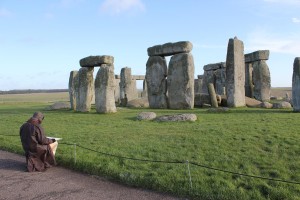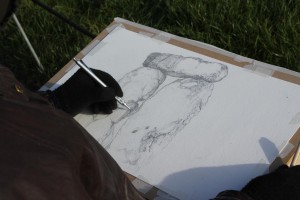Stonehenge – Tuesday 4th December
It’s a bright bitter December morning. The car park at Stonehenge is quite empty. Such a contrast to the mad busy months of the summer, and the experience of being here is quite different too.
On the tarmac walkway, a visitor from Malaysia asks one of the English Heritage staff if she’ll take his photo. He hands over his camera and gives instructions as to the type of photograph he wants. He poses, the shot is taken and he examines the image back on the screen. It’s not quite right. He’d like the whole of his body in please.
The staff members here are forever patient and polite. The diplomatic corps of Stonehenge.
Mark is still working on his detailed study of the large trilithon. It’s a slow, concentrated process, but the silverpoint drawing is emerging with incredible detail.
The crows are dipping in and out of the monument. I expect they have a more frugal diet throughout the winter months when there aren’t the tourist numbers to feed them.
A couple of helicopters scoot across the distant sky, but last week’s battle seems to be over.
A couple of Japanese girls are in the meadow area with the sheep. They’re conducting their own photo shoot. The girl posing has removed her coat and scarf and throws a series of shapes for her photographer friend. One of the EH staff strolls up to them and they jump back over the guide rope sharpish. Visitors here love those sheep. Apparently there’s a new range of sheep shaped souvenirs in the shop.
One of the most famous romantic paintings of Stonehenge done by JMW Turner in the 1820s has a flock of sheep foregrounded in the composition. Though some of the sheep don’t look very well, in fact they look to be dead or dying. The result of some terrible catastrophe. The current batch of sheep here look very healthy. They could have been selected by central casting as the most ideal sheep to create the perfect supporting crowd.
But I am aware that some people enjoy the possibility, the idea of dark deeds and traumas happening here. There’s the peculiarly named ‘Slaughter Stone’, one of the half buried horizontal stones lying in the grass, so called because the minerals in the rock give it a reddish tinge and some people love the idea that this echoes the blood spilt in human sacrifices. But there’s no evidence of human sacrifice here, just evidence of people wanting that particular story to be true.
A couple of men stand in front of me for their own photo session. They ask me to take a photo of them together. They’ve come a long way. Two gentle brothers, one from Bangladesh and one from London on a special visit here. They tell me that Stonehenge and the Pyramids are two of the world’s special places, and that when all else has gone, the only things in human endeavour that count are culture, art and love. I take photos for them on a smart phone and a small compact camera and am rewarded with a handful of chocolates. I feel thirteen, and happy for it.
A couple walk round dragging wheelie cases behind them. I recognise now that these visitors have taken public transport to get here, most likely the train to Salisbury and then a bus up to here. It demonstrates a certain determination to visit Stonehenge. Respect to the contemporary pilgrims.

